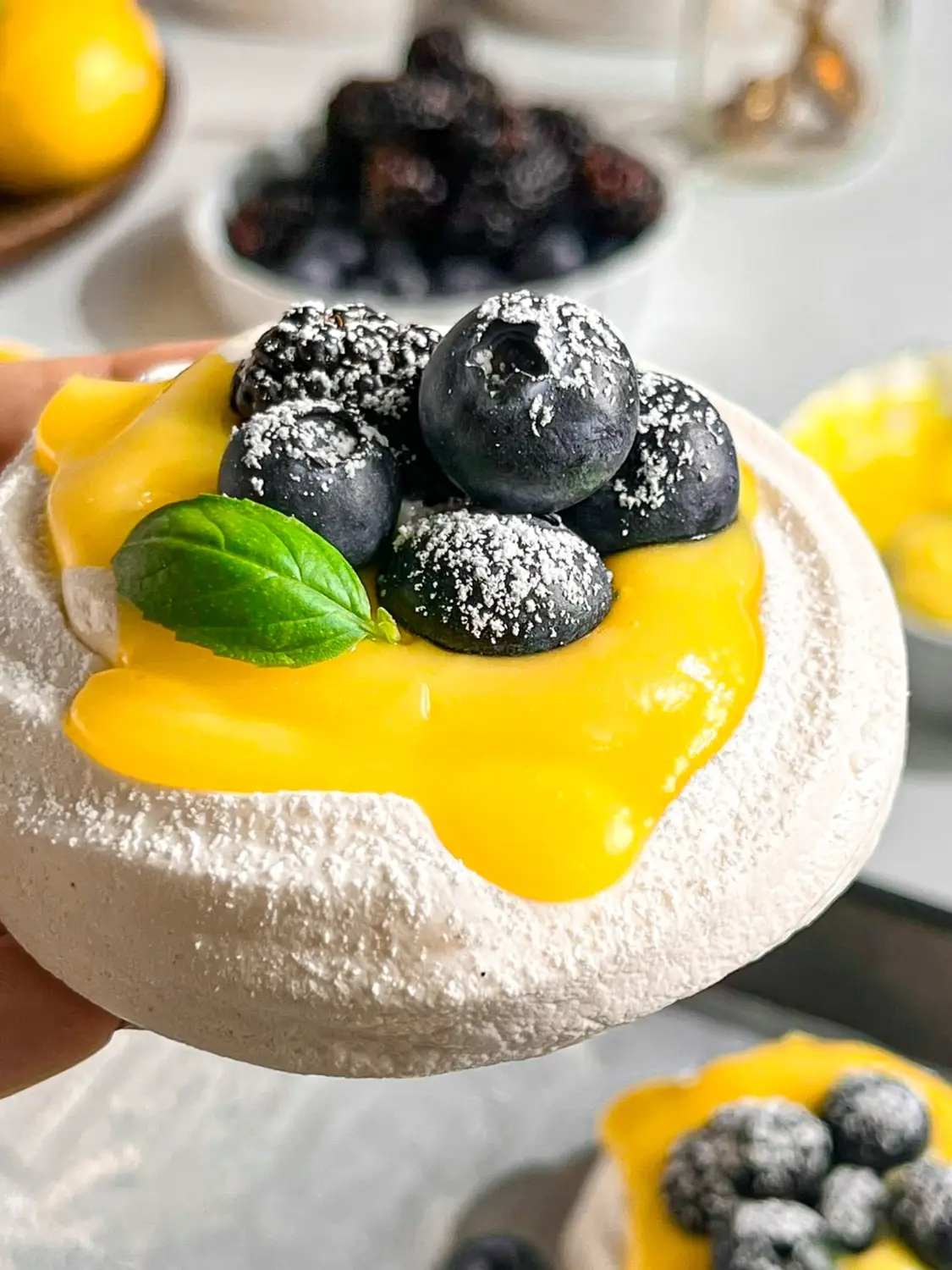Blueberry Lemon Curd Pavlova
This Blueberry Lemon Curd Pavlova is the ultimate dessert for celebrations or special occasions. With a crisp meringue base made from aquafaba, it’s completely eggless and dairy-free yet retains the classic pavlova texture—light and airy with a marshmallow-like center. Topped with a zesty homemade lemon curd, freshly whipped cream, and juicy blueberries, this dessert is as beautiful as it is delicious.
Yield: 12 servings
Prevent your screen from going dark
Equipment
- 2-3 Baking Trays
- Electric Whisk
- Piping Bag
- Pipe Tip Wilton 1M or 2D
Ingredients
Lemon Curd Ingredients
- 130 ml Milk* room temperature
- 95 ml Lemon Juice freshly squeezed
- 100 g Cane Sugar*
- 2 tbsp Cornstarch
- 28 g Butter* soft
- Pinch of Turmeric Powder for Color
Pavlova Ingredients
- 180 ml Aquafaba (brine from 2 cans of chickpeas, 350ml reduced to 180ml)
- ¼ tsp Xanthan Gum
- ¼ tsp Cream of Tartar
- ¼ tsp Salt
- 200 g Cane Sugar*
- 8 g Cornstarch
- 2 tsp Vanilla Extract
Instructions
Lemon Curd Instructions
- In a pot combine and whisk milk, lemon juice, sugar, cornstarch and bring it to boil on low-medium heat.
- Keep whisking as it comes to a boil. When it comes to a boil and has thickened, remove from the heat, and add butter.
- Stir the lemon curd until the butter is fully mixed and the lemon curd looks smooth and glossy.
- Add a pinch of turmeric for color at this point.
- Transfer in a bowl, Cover the surface of lemon curd with plastic wrap.
- Chill it completely in the fridge for 1-2 hours. Stir it smooth and use it as a topping for pavlova.
Pavlova Instructions
- To reduce aquafaba, pour it from a can of chickpeas into a saucepan and simmer over medium heat, stirring occasionally. Allow the liquid to reduce by about half until it reaches a thicker consistency. This process usually takes 10 to 20 minutes.
- Once thickened, remove from heat and let it cool to room temperature, as it will thicken slightly more as it cools. You can then use it immediately or store it in an airtight container in the fridge for up to 2days.
- Preheat the oven to 230°F (110°C). Lightly grease 2 -3 baking trays with oil and line it with parchment paper.
- In the bowl of a stand mixer, add the reduced aquafaba and whisk on medium speed until soft peaks form. Add the cream of tartar, xanthan gum, and salt. Increase the speed to medium-high and continue whisking.
- Gradually add the cane sugar, a quarter cup at a time, while whisking until the mixture forms thick, glossy, stiff peaks. Sift in the cornstarch and add the vanilla extract. Whisk for another 30 seconds to combine.
- Prepare a piping bag fitted with a star nozzle and fill it with the pavlova mixture. Pipe 2 1/2-inch-wide circles or nests on the prepared tray as shown in the video (link). Use a spoon to create an indentation in the center of each nest to make room for the cream.
- Bake the pavlovas for 2 hours, then turn off the oven. Leave the pavlovas to cool inside the oven with the door closed. The outside should be crisp and dry.
- Once cooled, store the pavlovas in an airtight container for up to 7 days.
- Before serving, add a dollop of freshly whipped cream to the center of each pavlova. Top with a generous spoonful of lemon curd, fresh blueberries, and a dusting of powdered sugar.
Notes
- Cup vs weighing scale: The US customary cup measurement serves as a rough estimate, as it can have uncertainties, so for precise results, it's recommended to weigh your ingredients using a digital scale in grams.
- Before you start to make any recipe, measure and prepare your ingredients so the process will go smoothly and easily.
- For teaspoon (tsp) and tablespoon (tbsp) measurements, please use measuring spoons and not the type of spoons you eat with for accuracy.
- Milk: You can use any dairy-free unsweetened milk (like almond, soy, oat) or Low-fat dairy based whole milk
- Butter: Dairy-free butter sticks or any butter of your choice
- Sugar: Cane sugar can be substituted with castor sugar. Ensure the sugar is vegan-friendly (some sugars are processed with bone char) or use organic cane sugar.
